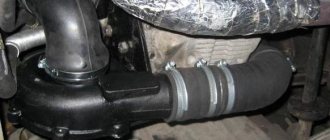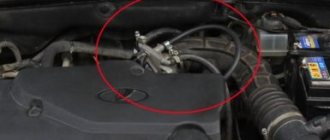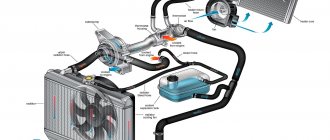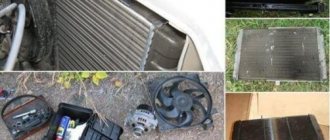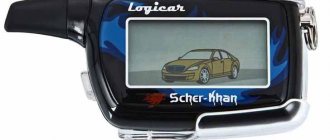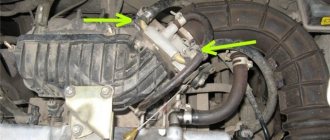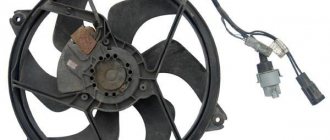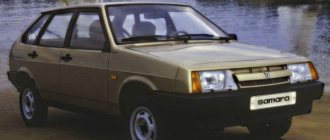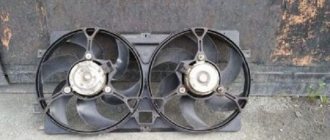We flush the engine cooling system on a VAZ-2110 (review of products)
Of course, all VAZ-2110 drivers are well aware that only 23% of the thermal energy that is released in our combustion chamber is beneficial. That is, less than a quarter of all heat is converted into kinetic energy. The rest of the heat simply warms the engine and escapes into the atmosphere. And, of course, everyone understands that the faster this excess heat is removed from the engine, the more efficiently it will work . This is why our top ten have introduced a liquid cooling system.
When to flush
During operation, the radiator of the cooling system may become clogged. Moreover, it comes from the outside and from the inside. Today, manufacturers are trying to use higher quality materials, but even they do not protect against corrosion and scale.
If the antifreeze used is not replaced in time, it can also negatively affect the condition of the unit. A complex of such phenomena leads to the cooling system becoming dirty and in need of urgent cleaning.
It is not difficult to determine contamination of CO (cooling system) by a constantly overheating engine, regardless of weather conditions.
The frequency of flushing directly depends on operating conditions, engine condition, CO components used, etc.
Why does the engine get hot?
There can be a lot of reasons, but in order to make claims on the cooling system, you must first make sure that the ignition is set correctly, the working mixture is not rich, and, after all, that there is antifreeze in the system. Anything can happen. If everything looks fine, then you need to check the thermostat. it may jam or simply serve its purpose and simply circulate the antifreeze in a small circle, not allowing it into the radiator. And it's easy to check. If, at a high temperature, the radiator bank on the indicator is barely warm, the problem is in the thermostat. It should open already at the engine operating temperature of 80-82 degrees and release antifreeze into the radiator. There may be a problem with the pump, but it's dying too loudly for anyone to notice.
If everything seems to be in order, but the engine continues to heat up rapidly, then the cooling system cannot properly remove heat. Because I got stuck. And it can get clogged:
- channels of the block cooling jacket;
- internal surfaces of radiator tubes;
- outer side of the radiator, mesh and honeycomb;
- pipes and thermostat;
- stove radiator.
Once it's clogged, it needs to be cleaned.
Engine cooling system flushing technology
To flush the engine cooling system in a VAZ-2110 with your own hands, you must follow the step-by-step instructions:
- Open the filler cap of the expansion tank.
- Place a container under the engine to drain the fluid.
- Remove the bolt from the drain hole located on the cylindrical block.
- The antifreeze that begins to pour out must fall exactly into the container, and not past it.
- When the flow of antifreeze stops, unscrew the cap, which is located at the bottom of the radiator, and again pour the liquid into the container provided.
- Put the plugs in place and pour distilled water inside, adding additives - a substance that will get rid of scale. Alternatively, you can add Hi-Gear product.
- Now rinse the system thoroughly with water, mixing it with the cleaning component. If something does not come out by gravity, it is recommended to clean the surface by exposing it to water pressure. To do this, disassemble the pipeline, freeing the upper component and the base of the radiator from the pipe. As soon as clear liquid flows at the bottom of the radiator, the flow of water can be turned off. This completes the procedure.
Air lock: what is it and how to remove it
An air lock may appear in the cooling system - usually this is the result of incorrect actions to replace antifreeze. To remove this interference you will need a screwdriver.
An air lock can quickly cause the engine to overheat. It can occur not only when replacing the coolant, but also when the system is depressurized (the hose is poorly fitted, the clamp is not secured).
This trouble is eliminated as follows:
- Remove the expansion tank plug.
- Locate the antifreeze inlet and outlet hoses.
- Apply several sharp pressures to the hoses. The air should come out.
- Close the expansion tank and start the engine.
Special cleaning products
There are special products designed for flushing the cooling system. They are quite expensive, but this is compensated by their high efficiency. Such products contain components that can cope with organic matter, grease, scale and rust. Special means are of the following types:
- neutral. They do not contain aggressive substances, therefore they are mainly used for preventive purposes;
- two-component. The most optimal and popular option for cleaning the cooling system. These products do their job perfectly;
- acidic and alkaline. Most often they are found in diluted form, because they have the most aggressive effect.
Recommendations
If the flushing procedure is carried out in winter in an unheated box, immediately after turning off the engine, drain the flushing fluid and add antifreeze.
Leaving flushing fluid at subzero outside temperatures can lead to defrosting of the cooling system, even leading to destruction of the radiator, water pump, and engine cooling jacket.
Defrosting the engine leads to a very expensive overhaul. The cooling system radiator is also not the cheapest spare part in a car.
How to wash the cooling system of a VAZ 2110 engine
Flushing the engine cooling system is divided into two types:
- External – the outside is cleaned from dust, insects, and other dirt. Using water or car shampoo.
- Internal – the inside is cleaned from accumulated scale, rust or any accumulated debris. Here the cleaning takes longer and requires force.
You can also flush the system in several ways:
- On one's own.
- Or in the workshop.
If you prefer to just pay money, then it will not be difficult to contact a specialist in any workshop where they will do everything for you. But how carefully and efficiently the master will do it is unknown. Therefore, if you do it yourself, you will not only save money, but also do the job efficiently, which not every master can guarantee.
Cleaning agents and methods
To flush the engine cooling system on a VAZ 2110, you can use different means. All of them have a certain effectiveness and nuances of application.
These tools used today include:
- Distilled water;
- Soda, vinegar, acids;
- Specialized CO purification products.
Now let's figure out what is good or bad about each of the presented options.
Distilled water
Despite everything, distilled water continues to be actively used when flushing the engine cooling system. It is difficult to explain the reasons for its popularity, since this product is not highly effective.
Flushing the radiator with distilled water
The procedure for flushing CO using distilled water is as follows:
- The old coolant is drained;
- Distilled water is poured into the system;
- The engine starts and sits with the engine running for 10, maximum 15 minutes;
- The engine is turned off, after which the distilled water is drained;
- The procedure is repeated until clean water comes out of the system.
The rating for the product is 1.5 out of 5.
Acid, soda, vinegar
This is a more stringent method of flushing the system when compared to using distilled water. However, the level of efficiency is significantly higher.
Cleaning OS with serum
To perform the flushing procedure, you will need:
- Prepare an appropriate solution, which includes caustic soda, lactic acid and vinegar. This mixture is poured into the cooling system. Just do not add too much lactic acid, as this is an aggressive agent that destroys the rubber elements of the CO;
- Then the system simply sits with the acidic liquid inside for no more than 8 hours. Ideally, it should stand for about 6 hours;
- During this period of time, the engine periodically starts and runs for a short time;
- When the specified time has elapsed, drain the acid solution, add distilled water and perform a procedure similar to the first washing method, where only water was used;
- 1-2 rinsing cycles with distilled water will be
- enough to remove all remaining acid solution;
- After this, all that remains is to fill in a new portion of antifreeze.
The rating for the product is 3.5 out of 5.
Specialized cleaning compounds
Go to any automotive chemical store, where you will find entire shelves with products designed for flushing engine cooling systems.
Get ready to spend a significant amount of money on them.
Specialized products are divided into four types:
- Neutral;
- Acidic;
- Two-component;
- Alkaline.
- Alkaline and acidic are considered the most popular because they demonstrate a high level of efficiency, plus from a financial point of view they turned out to be quite attractive.
- Two-component formulations include two main active elements - alkali and acid. They are offered in separate containers, the contents of which are poured into CO one at a time. This allows you to achieve excellent results and forget about a clogged cooling system and an overheated engine for a long time.
- Neutral products do not contain aggressive components. They serve for prevention, since there is no real effectiveness for strong cleaning.
The rating for the product is 4.5 out of 5.
It is strongly recommended to flush the engine in such cases.
Changing the brand and type of oil . If the oils are incompatible with each other or their viscosity index and additive set are radically different, you are unlikely to avoid flushing the engine. The fact is that mixing motor oils is not recommended at all, and if they are, among other things, incompatible with each other, then flushing in this case will prevent sad consequences.
Switching from synthetics to semi-synthetics and vice versa. If you want to change the type of oil to one or another that differs in composition and type, flushing the engine will avoid mixing and the formation of unwanted chemical reactions as a result. When heated, oil elements can interact with each other, forming new chemical chains that negatively affect the condition of engine parts and the entire engine as a whole.
The "dark past" of the car . If you bought a car secondhand, and you did not check with the former owner what exactly he poured into the engine of your new car, or you simply do not trust this person, it is better to play it safe and flush the engine. It is also not uncommon after a purchase that it turns out that the previous owner did not fill the engine with the oil recommended by the manufacturer; in this case, we are talking as much about the manufacturer of the engine oil as about its specifications and set of additives.
After engine overhaul . In the event of a malfunction for one reason or another and the need for major repairs, after completing all restoration work, it is recommended to flush the engine. This is done to clean the working surfaces of the power unit from technical debris.
Motor contamination . If you mistakenly poured bad oil into the engine or one that is contraindicated by the manufacturer, low-quality or inappropriate antifreeze, or the same fuel, it is recommended to flush the engine using a special flushing compound.

